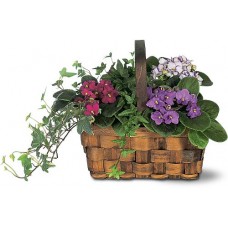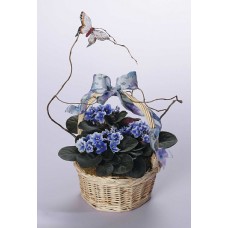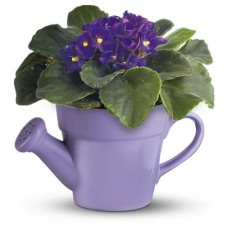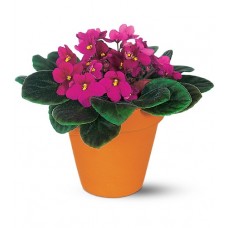Saintpaulia/African violet
Saintpaulia or African violet
Saintpaulia come the family of Violaceae, commonly called as spring flowering plants. It has about 400 to 500 kinds of violets in this family. They come from the Northern Hemisphere and can be found in Canada, Hawaii, Australasia, and in the Andes in South America. They thrive mostly in moist and in shaded places like hedgerows. Basically, these Violets have heart-shaped leaves and lopsided flowers. Its petals determine to the species they belong such as there are Violets with a spur at the end of every petal. These flowers differ in color where of some them are blue, or yellow, or cream and some have two colors like blue and yellow. Most Violets are little perpetual plants but some bloom annually while other Violets grow as small shrubs.
African Violet in a Basket
$52.99
Violet and Butterflies
$48.99
Violet in Watering Can
$42.99
Vivacious Violets
$28.99
African violet (Saintpaulia ionantha)
Have you noticed those beautiful violet flowers laid on the graves? Ancient Romans believed that these flowers symbolize their deep affection for their loved ones who passed away. Folklore relates these flowers with an ancient myth of one of the goddesses named Diana or Artemis and her nymph companions who had sworn to stay maidens. Their modesty was attributed to the violet.
Violets are classified into different types such as:
• African Violets which are considered as exotic house plants that live in warm temperature. Refrain from planting African Violets outdoors unless the temperature is warm. Its flower cannot stand temperature below 20 degrees. They need moderate to full sun exposure and watering twice every week. Prevent from saturating the soil because plenty of water can kill the plant. Avoid the leaves from getting wet because it can lead to blemishes and discoloration. Repotting them is needed when they grow bigger.
• Wild Pansy, also known as a field violet or Johnny Jump-Up, is a violet flower that comes in purple shades but can be in other colors such as yellow, white and blue. Some are mixed colors. They can grow as much as 6 inches high. The flowers are soft and oval or roundish petals and leaves are green and heart-shaped. They thrive on full sun and rich well-drained soil.
• Common Meadow Violet can be found in the wild across New Jersey, Illinois, Rhode Island, and Wisconsin. This type of Violet plant is common because it is easy to grow and nurture for. The petals are big, soft and round which resembles the windmill. The center and the foliage is light green and the flowers are edible. There are some people who use the plant to make candies and jellies. Common Meadow Violet has been found to have high doses of Vitamin A and Vitamin C. In our modern world, Violets can be found as indoor plants at home which represent family and marriage. They are also used as wedding bouquets which symbolize the couple’s promise and faithfulness.
• The African Violet is Small and compact with very dark green leaves in size, these delicate flowers tend to be soft and contain lots of fur. The miniature stature of this flower can allow it to grow to up to a diameter of 6’’ while the standard is 8-12inches. African violets bloom all year into shades of blue, purple, pink, fuchsia or white. Technology has also produced a way of blooming the African violets into double and bi-colored shades. This means that one flower can bloom in more than one shade of color.
• There are about two known types of the African violet. These can be classified hanging as well as trail varieties of African violet. Hanging violets need a supporting system or anchor to support its growth and spread as they have a weak stem. They are more often found wandering on other plants with solid and strong steams or along the walls. On the other hand, trail African violets have their stems which means that they don't need external support. They are characterized by the dense production of leaves or foliage. The Saintpaulia ionantha and are known to have originated from Tanzania and eastern Africa. They resemble the known violets which explain the origin of their name.
Care
· Keep the flowers in a bright place and indirect from the sun.
· Water the flower with enough clean and pure water from the bottom after1-2’’ of the soil has dried.
· Use only enough of the special fertilizer for the flower on a monthly basis at young stages.
· Keep under 75-80 degrees (daytime) and ten degrees lower at night.
· Remove the dead blooms and stems while keeping the soil dry encourages flowering.
· Use Qtip dipped in alcohol or neem oil or commercial insecticides to get rid of pests.
· Keep the water off leaves and maintain good air circulation
· Use rich, airy, potting medium soil if not special soil. Re-pot every 6-12 months with fresh soil.
· Keep the flower root bound to encourage more flowering
· Remove 2-3 leaves a month to encourage the development
FAQs
My African violet plant has cracking and brittle leaves. Why is that?
It is as a result of excess plant food available in fertilizers. To avoid this, always use it in the early stages and dilute it to half the recommended plus pure water avoiding avoid direct sunlight
How do I get my African violet to bloom more and have increased foliage?
Use smaller pot and proper plant food proportion. Also, move it to a brighter place and water it with distilled water.
What’s the best way to propagate African violet plant?
During spring, obtain a leaf cutting from the plant. Remove a leaf with its stem attached and deep it in rooting hormone then plant it in peat based quick draining soil.
• Pay a visit to Toronto Office plants today to see our collection of African violets.










